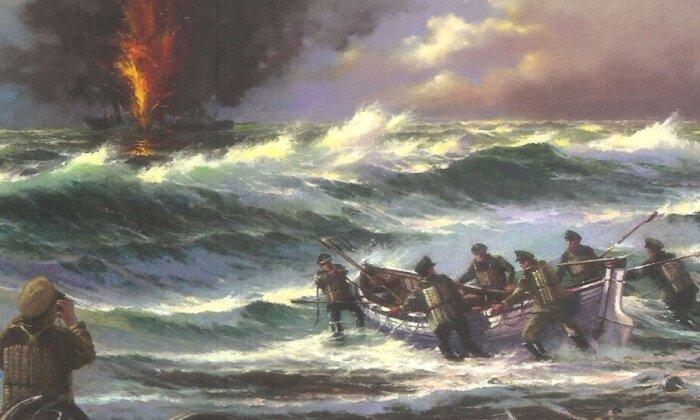Each generation of the Midgett family of North Carolina’s Outer Banks recognizes a valiant maritime rescue involving its ancestors, with one in particular distinguished for leadership above and beyond.
Two U.S. Coast Guard cutters are named after him, a book has been written about his level-headed and heroic deeds, and North Carolina’s Chicamacomico Life-Saving Station (CLS) and Museum features photographs, a documentary, books, and plenty of interesting information on Keeper John Allen Midgett, Jr. His brave guidance on the evening of Aug. 16, 1918, resulted in what the U.S. Coast Guard still regards as one of the top rescues in American maritime history.

Maritime historian and author Kevin Duffus wrote a thorough account of the rescue in his 2018 book titled “Into the Burning Sea: The 1918 Mirlo Rescue.” The book sets the scene for the day’s events:
“At noon on Friday, August 16th, surfman No. 8 of Chicamacomico Coast Guard station, 31-year-old Leroy Midgett, ascended the two flights of steep, narrow ladder steps to the watchtower to relieve his distant cousin, the tall, gangly Clarence Midgett, who had been on duty since 6 a.m.”
Then, around 4:30 p.m. on the same day, Clarence Midgett observed a great mass of water shooting up into the air as well as billowing white smoke. Duffus conveyed in his centennial book:
“‘I’ll be darned, that tanker was just torpedoed, [Clarence] Midgett murmured to himself. ‘A ship has been torpedoed!’ he shouted to the floor below. He then turned from the windows and leapt through the hatch, practically free-falling down the ladder to find Captain Johnny.”
Captain Johnny, as he was known to his men, was officially Chief Boatswain John Allen Midgett, Jr., who had followed in his father’s footsteps, and at age 22, was one of the lifesavers of a six-mile stretch of the Outer Banks, where his family had resided since the 1700s.
A Daring Rescue
That night, Captain Johnny and enlisted Coast Guardsmen—three of whom were family members—managed to launch a surfboat into the ocean and steer it toward the fiery seascape of burning fuel in order to find survivors. The rescuers afterwards described the melee as “hell on water.”The fuel and the Mirlo’s debris floated on the sea water and burned, the rescue boat’s paint blistered, and the rescuers’ hair and clothing were singed.
A Previous Rescue
Nineteen years earlier, another incident occurred involving another intrepid Midgett, Surfman Rasmus S. Midgett, who trained at CLS. While patrolling the beaches, he spotted from his horse the barkentine [sailing ship] Priscilla breaking up along the shores. The San Ciriaco hurricane of August 1899 caught several ships in the storm. Midgett swam to the wrecked ship and, without aid or equipment, managed to rescue 10 men. He was honored with the Gold Life-Saving Medal.In fact, the U.S. Coast Guard notes that, to date, 10 members of the Midgett family have been recognized with awards by the Coast Guard for saving lives.
The need for maritime rescues along North Carolina’s Outer Banks is essentially due to “the pronounced eastward bulge of the barrier islands,” said Duffus in a phone call. “North and southbound coasting vessels had to navigate around the Outer Banks, passing dangerously close to Cape Lookout and Cape Hatteras and the submerged shoals that extend seaward by a dozen miles or more.”

So many shipwrecks have occurred that the 200-mile strip has been referred to as “the Graveyard of the Atlantic.” It’s estimated that 1,000 ships remain on the ocean floor, according to Cape Hatteras National Seashore. Lighthouses and life-saving stations were erected as aids to navigate into harbors, and a few were built to mark hazards such as dangerous shoals.
Chicamacomico Historical Association’s (CHA) executive director John Griffin, who works with Captain Johnny’s descendants on the association’s board, quipped on a call:
“You can throw a stone around here and hit a Midgett. But seriously, they (the Midgett family) don’t think it’s a big deal what Captain Johnny did—and what other family members working for life-saving stations have done and are still doing [with the Coast Guard]. It’s their job. I have never heard any of them boast or make it known what any family members have done to save lives along the Outer Banks.”

Jonna Midgett is also the matron of honor for the cutter USCGC Midgett, and she has served on the CHA board for many years. Though she never met her great-grandfather, Jonna knows him through oral and written history, photographs, paintings, and more. “I think he must have been a very intelligent man, with a lot of fortitude, and the right person for the position. He knew navigation and how to gauge the waves, or they wouldn’t have gotten the lifeboat out there to save so many of the crewmen on the Mirlo,” she said by phone.
“There is a huge connection to this land and the sea. I’m fortunate to have ancestors who have done so much that is honorable. From as long as I can remember, I heard the rescue stories. They are an integral part of my life.”







